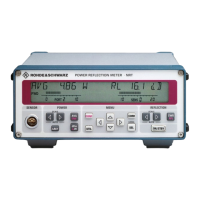Remote Control - Commands
NRP2
274User Manual 1173.9140.02 ─ 07
[SENSe<[1]..4>][:POWer]:BURSt:DTOLerance <tolerance>
The end of a burst (power pulse) is recognized when the signal level drops below the
trigger level. Especially with modulated signals, this may also happen for a short time
within a burst. To prevent the supposed end of the burst from being recognized too
early or incorrectly at these positions, a time interval can be defined via
SENS<[1]..4>:BURS:
DTOL (drop-out tolerance) in which the pulse end is only rec-
ognized if the signal level no longer exceeds the trigger level. This is shown in the fig-
ure below: The drop-out time, i.e. the time in which the signal remains below the trigger
level, is shorter than the drop-out tolerance. The burst end is thus recognized correctly.
Drop-out time
Trigger level
Power
Time
BURSt:DTOLerance
Pulse interval
BURSt:DTOLerance
Fig. 6-10: Meaning of drop-out TOLerance
Parameters:
<tolerance> float_value
Range: depending on sensor
*RST: depending on sensor
Default unit: S
[SENSe<[1]..4>][:POWer]:TGATe<[1]..4>[:EXCLude]:MID:OFFSet[:TIME] <time
interval>
Together with SENS:TGAT:MID:TIME, allows a time interval in a timegate to be
blanked out. SENS:TGAT:MID:OFFS:TIME determines the distance from the start of
the measurement to the start of the interval to be blanked out (see figure 6-11MID
parameter in the Timegate mode).
Parameters:
<time interval> float_value
Range: depending on sensor
*RST: depending on sensor
Default unit:
S
SENSe (Sensor Commands)
北京海洋兴业科技股份有限公司(证券代码:839145)

